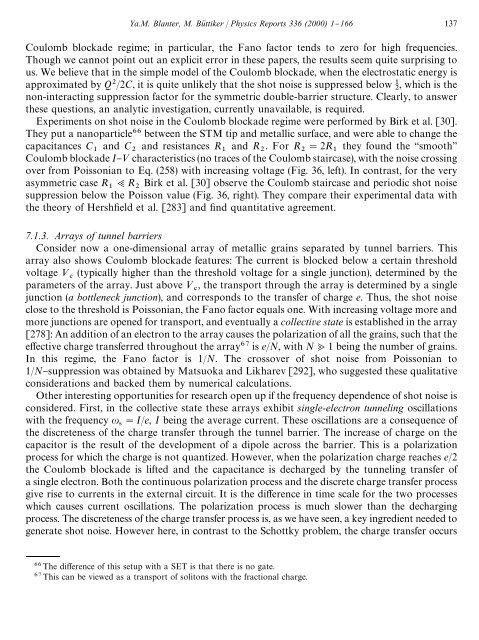shot noise in mesoscopic conductors - Low Temperature Laboratory
shot noise in mesoscopic conductors - Low Temperature Laboratory
shot noise in mesoscopic conductors - Low Temperature Laboratory
Create successful ePaper yourself
Turn your PDF publications into a flip-book with our unique Google optimized e-Paper software.
Ya.M. Blanter, M. Bu( ttiker / Physics Reports 336 (2000) 1}166 137<br />
Coulomb blockade regime; <strong>in</strong> particular, the Fano factor tends to zero for high frequencies.<br />
Though we cannot po<strong>in</strong>t out an explicit error <strong>in</strong> these papers, the results seem quite surpris<strong>in</strong>g to<br />
us. We believe that <strong>in</strong> the simple model of the Coulomb blockade, when the electrostatic energy is<br />
approximated by Q/2C, it is quite unlikely that the <strong>shot</strong> <strong>noise</strong> is suppressed below , which is the<br />
non-<strong>in</strong>teract<strong>in</strong>g suppression factor for the symmetric double-barrier structure. Clearly, to answer<br />
these questions, an analytic <strong>in</strong>vestigation, currently unavailable, is required.<br />
Experiments on <strong>shot</strong> <strong>noise</strong> <strong>in</strong> the Coulomb blockade regime were performed by Birk et al. [30].<br />
They put a nanoparticle between the STM tip and metallic surface, and were able to change the<br />
capacitances C and C and resistances R and R .ForR "2R they found the `smootha<br />
Coulomb blockade I}< characteristics (no traces of the Coulomb staircase), with the <strong>noise</strong> cross<strong>in</strong>g<br />
over from Poissonian to Eq. (258) with <strong>in</strong>creas<strong>in</strong>g voltage (Fig. 36, left). In contrast, for the very<br />
asymmetric case R ;R Birk et al. [30] observe the Coulomb staircase and periodic <strong>shot</strong> <strong>noise</strong><br />
suppression below the Poisson value (Fig. 36, right). They compare their experimental data with<br />
the theory of Hersh"eld et al. [283] and "nd quantitative agreement.<br />
7.1.3. Arrays of tunnel barriers<br />
Consider now a one-dimensional array of metallic gra<strong>in</strong>s separated by tunnel barriers. This<br />
array also shows Coulomb blockade features: The current is blocked below a certa<strong>in</strong> threshold<br />
voltage < (typically higher than the threshold voltage for a s<strong>in</strong>gle junction), determ<strong>in</strong>ed by the<br />
parameters of the array. Just above < , the transport through the array is determ<strong>in</strong>ed by a s<strong>in</strong>gle<br />
junction (a bottleneck junction), and corresponds to the transfer of charge e. Thus, the <strong>shot</strong> <strong>noise</strong><br />
close to the threshold is Poissonian, the Fano factor equals one. With <strong>in</strong>creas<strong>in</strong>g voltage more and<br />
more junctions are opened for transport, and eventually a collective state is established <strong>in</strong> the array<br />
[278]: An addition of an electron to the array causes the polarization of all the gra<strong>in</strong>s, such that the<br />
e!ective charge transferred throughout the array is e/N, with N
















